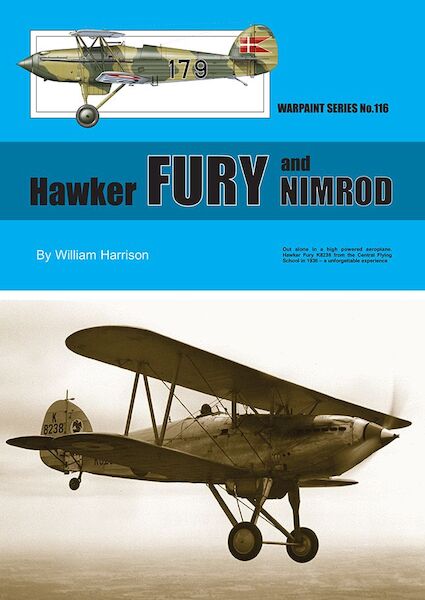
- Ship to Netherlands
Snel Zoeken
Feestdagen
Gewijzigde of bevestigde openingstijden van de Luchtvaart Hobby Shop in Aalsmeerderbrug op de volgende data:
Aviation Megastore website is be- schikbaar zonder beperkingen. Bestellingen worden verwerkt tijdens openingstijden van de winkel.
| ma | 5 mei | Gesloten: Liberation Day |
| do | 29 mei | Gesloten: Ascension Day |
| ma | 9 juni | Gesloten: Whit Monday |
Hawker Fury, Hawker Nimrod
Artikelcode ws-116
Hawker
NL incl. BTW € 18,95
€ 17,39 excl.BTW
€ 17,39 excl.BTW
Serie Warpaint Series No 116
Uitgever/Merk Hall Park
Schrijver William Harrison
Formaat a4
Pagina's 125
Uitvoering Soft cover
Taal English
Categorie Luchtvaartboeken
Subcategorie WW2 UK » WW2 UK Aircraft
Voorraad slechts 1 resterend
Dit artikel is toegevoegd aan onze database op maandag 23 juli 2018.
Your reliable Aviation Book Source since 1989
ook in deze serie:
| artikel | Uitgever/Merk | Serie/schaal | Prijs € | ||
 | Armstrong Withworth AW.650/660 Argosy | Hall Park | Warpaint Series No 71 | € 16,95NL incl. BTW | |
 | Avro Lincoln | Hall Park | Warpaint Series No 34 | € 16,95NL incl. BTW | |
 | Avro Manchester | Hall Park | Warpaint Series No 103 | € 15,95NL incl. BTW | |
 | Douglas C54/R5D Skymaster & DC-4 | Hall Park | Warpaint Series No 109 | € 22,95NL incl. BTW | |
 | Fairey Swordfish | Hall Park | Warpaint Series No 12 | € 15,95NL incl. BTW | |
 | Fiat G91 | Hall Park | Warpaint Series No 49 | € 16,95NL incl. BTW | |
 | Grumman F4F Wildcat | Hall Park | Warpaint Series No 9 | € 13,95NL incl. BTW | |
 | Handley Page Hastings | Hall Park | Warpaint Series No 62 | € 16,95NL incl. BTW | |
 | Mikoyan Gurevich MiG15 | Hall Park | Warpaint Series No 120 | € 18,95NL incl. BTW | |
 | North American RA5C Vigilante | Hall Park | Warpaint Series No 97 | € 21,95NL incl. BTW |
Productomschrijving
The first RAF front line fighter to achieve more than 200 mph was the Hawker Fury, and its naval counterpart the Hawker Nimrod. These two attractive fighters came from the design office of the late Sydney Camm, Hawker's chief designer. The Fury started life as a private venture known as the Hornet but when this machine exceeded expectations the name was changed to Fury. Although only ordered in small numbers owing to financial constraints during the Great Depression production eventually exceeded 260 machines with orders from the RAF, Royal Navy, Persia (now Iran), Portugal, Spain, Yugoslavia and more than 30 supplied (ex-RAF) to the South African Air Force. The Fury entered service with No.43 Squadron who accepted 16 during May 1930 and stayed in front line service until January 1939 when it was replaced by the Gloster Gladiator, although quite a few remained in the training role until mid-1941. The Furies were used in combat during WWII by Yugoslavia where they were quickly despatched by the more modern fighters of the Luftwaffe. South Africa used Furies in the East African war until 1941 and the three supplied to Spain were in action, one of them serving on both sides! The Nimrod, while bearing a distinct resemblance to the Fury, flew early in 1930. Changes for the RN included longer exhaust pipes extending down both sides of the fuselage as far as the pilot's cockpit; an oil cooler fitted beneath the engine bay and at a later date arrester gear was fitted for carrier use. Later series Nimrods featured a larger tail surface to improve inverted spinning characteristics when fitted with floats. Deliveries of Nimrods started in September 1933 and they remained in use until May 1939. Only a small number of Nimrods found their way abroad, two went to Denmark to act as pattern aircraft for licensed production, one was shipped to Japan and one to Portugal. Although one Fury managed to survive in the scrapyard of a London dealer it fell to John Isaacs, a draughtsman from Vickers Armstrong, to design and build both a 1/7th scale Fury and Spitfire, both of which continue to be built by members of the Light Aircraft Association, née the Popular Flying Association. This book is written by William Harrison and is superbly illustrated by Richard J.Caruana.
Werken bij Luchtvaart Hobby Shop?
© 1989–2025 Luchtvaart Hobby Shop B.V.
